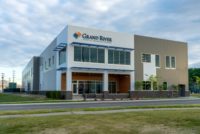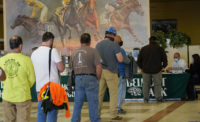The rush to move COVID-19 vaccines through development, testing, production and global distribution has pharmaceutical and R&D firms and their industry designers and builders rushing to maximize space and productivity. New announcements in November by pharma giant Pfizer and biotech startup Moderna Therapeutics of successful early test results are accelerating the pace.
Any imminent virus vaccine manufacturing looks set to take place in existing facilities, although some of these facilities are recently built or still under construction.
The facilities themselves have to meet a strict level of regulatory scrutiny to be able to produce pharmaceutical products under what is called "good manufacturing practices," or GMP. This makes any new manufacturing construction a lengthy and laborious proposition, with new plants generally planned well in advance.
It’s more likely that pharma companies will turn to production partners and contract manufacturers and repurpose production lines to meet what will be huge demand. It’s possible to build onto existing plants, the Pfizer spokesperson says, although there are no current plans to do so.
Acceleration
The spokesperson says it will ramp up production capacity in existing space to supply any potential virus vaccine—the current candidate for which is still being evaluated. With regulatory approvals, Pfizer and German partner BioNTech would produce 50 million doses by year’s end and up to 1.3 billion in 2021.
Vaccine components will be manufactured at Pfizer plants in Puurs, Belgium; Chesterfield, Mo.; and Andover, Mass.; with assembly in Kalamazoo, Mich. The drug firm has been active in adjusting its manufacturing portfolio over the last decade, investing $465 million at the Michigan plant—part of a planned $5 billion U.S. capital projects investment, observers say.
German pharma firm CureVac is in advanced testing of a vaccine, with apparent support from U.S. manufacturer Tesla Inc. The two firms share a ribonucleic acid (RNA) bioreactor patent application, and Tesla has posted hints about building “RNA microfactories” for CureVac.
CureVac now has four protocol-ready manufacturing facilities at its Tübingen headquarters, the most recent under the general planning direction of Koppenhöfer+Partner, Stuttgart with Klett Ingenieur subcontracted for technical equipment. The European Investment Bank in July extended $85 million in financing to CureVac, part of which was intended to speed up work on its latest plant.
CureVac—which did not respond to requests for comment—has its immediate capacities in place.
UK Effort
The U.K. also has a new facility coming online, planned and prepared for before the pandemic but since boosted into high gear because of it.
Ground work got underway in April near Oxford, England, on a 75,300 sq-ft site called the Vaccines Manufacturing and Innovation Centre. It will boast state-of-the-art drug development labs but also robust manufacturing capabilities.
Construction is proceeding under general contractor Glencar Construction, with the facility to come on line in 2021 to produce about 70 million doses of vaccine. Funding includes $86 million in UK federal funding and in-kind contributions from Janssen-the European unit of Johnson & Johnson, and from Merck and GE Healthcare; vaccine R&D is being done by Oxford University, Imperial College and the London School of Hygiene and Tropical Medicine.
Results also are pending for vaccines developed by a Janssen and Harvard University, and by Oxford University and drug firm AstraZeneca.
Working Globally
Design-build giant Jacobs confirms expedited work on an AstraZeneca plant retrofit in West Chester, Ohio, to upgrade an idle production line for COVID-19 vaccine. John Noble, head of Jacobs’ life sciences unit, declines to provide further detail on the scope or value of the EPC contract, citing client contract terms, but says design and construction that would normally take 12 to 18 months was done in three. “We had the client in the room with the project team from day one,” he told ENR. “The job “wasn’t a massive project, but important.”
Noble, a PhD biomedical engineer, would not confirm details of Jacobs’ work for Pfizer, although the drugmaker is a long-time client, according to online corporate references. He says about 250 Jacobs staffers are working on virus-related projects in Cincinnati, Philadelphia, Dublin and Cork in Ireland, Milan, Singapore and Delhi.
According to Noble, super-cold freezers such as those currently needed to store Pfizer’s vaccine at about -92° F are common in production plants but not distribution sites. “We are seeing projects across the network for bulk storage,” says Noble. who says Jacobs is not involved in the work.
Ready Retrofit
Design-builder CRB had to ramp up completion of a $60-million fill-and-finish facility in Grand Rapids, Mich., last spring for contract manufacturer Grand River Asceptic Manufacturing (GRAM), as the virus hit and the plant was eyed to support vaccine making. “Some elements really had to be expedited,” says Jesse Adams, CRB senior project manager.
GRAM’s 61,500-sq-ft facility was qualified and operational by July.
John Wichelt, vice president of client pharmaceutical services, says GRAM has a contract with the U.S. government, under its Operation Warp Speed vaccine program, for the facility’s full capacity for one year. Production has begun at the plant to make the vaccine, now in clinical trials, by GRAM’s contract partner, Johnson & Johnson.
Read more about how vaccine production is bringing aseptic manufacturing and EPC firms into the limelight.
Fast-Tracking
Moderna also is working with contract manufacturers to make 500 million to 1 billion doses of its vaccine next year. A Lonza Biologics plant in Portsmouth, N.H., ramped up production in late September, and another in Switzerland will start before the end of 2020, says the firm.
Fast-track is nothing new for Moderna nor Massachusetts-based Wise Construction, which in 2018 completed in just 33 weeks the start-up's current 200,000-sq-ft clinical production plant at a former Polaroid factory site in Norwood, Mass.
The $111-million project was “three to four times faster than a typical one of this size and scope,” says a Wise spokeswoman. “Technologies were so promising, it needed to quickly build out to manage rapid scale-up of clinical studies,” she adds.







Post a comment to this article
Report Abusive Comment